Fighter 101: A Beginner’s Guide to Heroic Combat
The warrior stood high atop a plateau, her matted hair dripping with sickly green blood. Her two blades, one perfectly straight shortsword and one wickedly curved scimitar, trembled in her hands. She looked down at the carnage surrounding her. She looked at the corpses of the goblins that surrounded her, their blood clotting the dust of the plateau. She closed her eyes and breathed deeply, filling her lungs with thin highland air. The world around her grew silent, and she felt warmth return to her aching muscles.
She opened her eyes, and all the sensations of the world returned to her—including the hideous, guttural war cry of the hobgoblin charging at her. She adopted a fluid stance as the slavering monster raised its greatsword high above its head. It brought the blade down hard, but she pushed off of the ground and dodged to the right, kicking dust into its face as she did so. A larger dust cloud engulfed both warriors as the greatsword slammed into the sandstone of the plateau.
Even as she dodged, the fighter swung her scimitar in a quick riposte, biting deep into the hobgoblin’s unprotected armpit. Its blood splattered across the already gore-drenched battlefield. The fighter dug her heels into the dust to stop her motion. Both warriors came to a halt and turned to face their enemy. The fighter smiled.
“I don’t have a grand speech for you,” she shouted, hoarse and panting. She raised her blades and rushed the hobgoblin. “There are no words to express what I feel,” she said, swinging her scimitar in a wide overhead arc. “None at least, that you would understand!”
The hobgoblin roared in her face and raised his greatsword above his head, and steel rang against steel. The two locked eyes and blades for a split second, and she smiled again. The shortsword in her left hand flashed in the afternoon sun as she plunged it into her distracted foe’s flank. Its eyes went wide, and its anguished bellowing rang in her ears. It lowered its greatsword, and she swung her freed scimitar in a swift, horizontal stroke.
She walked past the hobgoblin, flicking its blood from her blades. She stopped only when she heard the thump of its head against the stone, and she turned to see the body collapse before.
“Words have never been my strong suit” she said, a hard look in her eyes. “But my swords are the only language I need.”
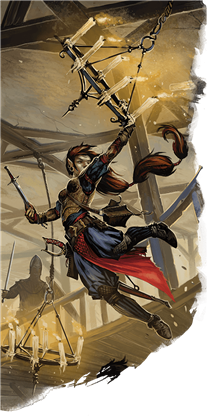 You are playing a fighter, a brawler who will grow to become a peerless warrior. Your power comes from no one but yourself, from nowhere but your own spirit. You need not rely on the esoteric power of magic, the whims of the gods, or the cruel demands of an otherworldly patron. The only oath you swear is to your sword arm.
You are playing a fighter, a brawler who will grow to become a peerless warrior. Your power comes from no one but yourself, from nowhere but your own spirit. You need not rely on the esoteric power of magic, the whims of the gods, or the cruel demands of an otherworldly patron. The only oath you swear is to your sword arm.
Your self-reliance is powerful, but it comes at a thematic cost. A fighter can be any sort of warrior from a spry fencer to a stoic knight to a brutish street thug. This thematic flexibility is a boon for some, but it could lead the fighter to be seen as a boring chassis for better ideas.
Let’s dispel that myth, because the fighter is anything but boring. This guide will cover the basics of being a fighter, walking you through the first 5 levels, focusing on how to make the most of your class features, and helping you use them to inform your character.
Quick Build Expanded: Building Your Fighter
This isn’t a character optimization guide, but the first step in playing your class effectively is building it effectively. The Quick Start guidelines in the Player’s Handbook are a good start, but don’t go far enough for most new players. Here’s an expanded Quick Start guide. This guide assumes you’re using the D&D Beyond Character Builder, which includes helper text for new players.
- Under “Character Preferences,” turn off “Playtest Content” and “Show Unarmed Strike”
- Choose your Race. While any race can be a good fighter, you may want to choose a race that improves your Strength, Dexterity, and/or Constitution scores.
- Mountain dwarves make excellent melee fighters because of their bonuses to both Strength and Constitution.
- Elves are also good fighters if you want to use bows or dual-wield light weapons, because of their bonus to Dexterity.
- Finally, half-orcs make outstanding melee fighters because of their bonus to bonus to Strength and Constitution, and because of their Relentless Endurance and Savage Attacks trait.
- Choose Fighter as your class (obviously).
- Choose skills that fit who you want your character to be. Skills that play to your strengths are useful, but also consider shoring up some of your weaknesses in order to make yourself a more balanced character. This part is up to you!
- Think about what role you want to fill in the party. Let’s look at this in greater detail.
What Kind of Fighter are You?
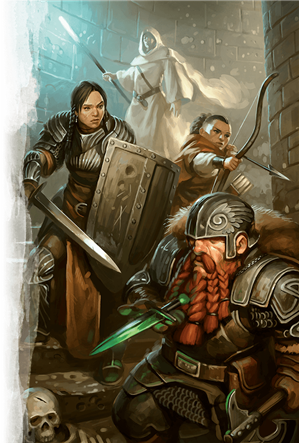 As a fighter, it should be obvious what your strengths are—you are built to fight! Unlike other classes that can choose to specialize in exploration or support, you have three clear cut paths when building your character. In combat, do you want to take on the role of Offense, Defense, or Tank?
As a fighter, it should be obvious what your strengths are—you are built to fight! Unlike other classes that can choose to specialize in exploration or support, you have three clear cut paths when building your character. In combat, do you want to take on the role of Offense, Defense, or Tank?
(And note, I’m using Offense, Tank, and Support as shorthand. No part of D&D refers to characters in this way, but it’s an easy way to discuss the different roles characters serve in the party.)
Offense
As an offensive fighter, you’ll focus on taking down enemies through rapid, overwhelming force.
- Choose the Great Weapon Fighting or Two-Weapon Fighting fighting styles.
- If you chose Great Weapon Fighting, place your highest ability score in Strength. If you chose Two-Weapon Fighting, put your highest ability score in Dexterity. Put your second highest ability score in Constitution, and the others as you see fit. (If you want to play a spell-slinging Eldritch Knight fighter starting at 3rd level, put your second highest ability score in Intelligence instead of Constitution.)
- Choose any background you wish that supports your character concept.
- Finally, choose your equipment by clicking on “EQUIPMENT” when promoted to “Choose EQUIPMENT or GOLD”. Choose:
- Chain mail
- A two-handed martial weapon like a greataxe or greatsword and a shield if you chose Great Weapon Fighting or two shortswords or two scimitars if you chose Two-Weapon Fighting
- A light crossbow and 20 bolts if you chose Two-Weapon Fighting or two handaxes if you chose Great Weapon Fighting
- A dungeoneer’s pack or an explorer’s pack, depending on your character concept.
If you want to be an offensive archer instead of a melee fighter, make all the same choices as if you were building a Two-Weapon Fighting fighter, but choose the Archery fighting style instead of Two-Weapon Fighting, and select leather armor, a longbow, and 20 arrows instead of chain mail.
Defense
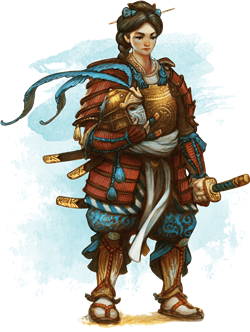 A defensive fighter sacrifices a small fraction of the offensive fighter’s raw damage for a little bit more armor and staying power.
A defensive fighter sacrifices a small fraction of the offensive fighter’s raw damage for a little bit more armor and staying power.
- Choose the Defense or Dueling fighting style.
- Put your highest ability score in Strength and your second highest score in Constitution, and the others however you see fit. (If you want to cast spells as an Eldritch Knight fighter starting at 3rd level, put your second highest score in Intelligence instead.)
- Choose any background you wish that supports your character concept.
- Finally, choose your equipment by clicking on “EQUIPMENT” when promoted to “Choose EQUIPMENT or GOLD”. Choose:
- Chain mail
- A one-handed martial weapon like a battleaxe, longsword, morningstar, or rapier and a shield.
- Two handaxes
- A dungeoneer’s pack or an explorer’s pack, depending on your character concept.
A defensive fighter plays fairly similarly to an offensive one, especially at 1st level. You’ll always want to be in melee with the enemy if possible, using your bulk to stay alive as you chop through the enemy. As you gain levels and a greater diversity of class features, the Offense and Defense playstyles start to diverge.
Tank
![]() A tank trades both raw offense and defense for more specialized options that help keep their allies safe.
A tank trades both raw offense and defense for more specialized options that help keep their allies safe.
- Choose the Protection fighting style.
- Put your highest ability score in Constitution and your second highest score in Strength, and the others however you see fit. (You probably shouldn’t play an Eldritch Knight as a tank, but if you really want to, put your third highest ability score in Intelligence.)
- Choose any background you wish that supports your character concept.
- Finally, choose your equipment by clicking on “EQUIPMENT” when promoted to “Choose EQUIPMENT or GOLD”. Choose:
- Chain mail
- A one-handed martial weapon like a battleaxe, longsword, morningstar, or rapier and a shield.
- Two handaxes
- A dungeoneer’s pack or an explorer’s pack, depending on your character concept.
At 1st level, the Protection fighting style is the most significant part of your tanking toolset, as it allows you to use your reaction to make it harder for enemies to hit your allies. This may encourage monsters to attack you instead of your allies, since you can’t use your Protection ability to defend yourself, only others. This is exactly what you want; your high armor and Constitution will help you weather hits much better than your roguish and wizardly allies.
Fighting like a Fighter
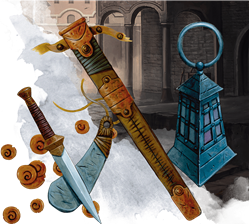 For the first three levels of your fighting career, your style of gameplay will be roughly the same no matter what kind of role you want to play in the party. If you’re wearing medium or heavy armor and wielding a melee weapon, you’ll want to get into the fray and stay there until the fight is over. Even if you’re about to be knocked out, don’t run unless the party agrees that they need to retreat. You’re more useful dealing damage and taking hits until you’re out cold than you are disengaging in order to heal.
For the first three levels of your fighting career, your style of gameplay will be roughly the same no matter what kind of role you want to play in the party. If you’re wearing medium or heavy armor and wielding a melee weapon, you’ll want to get into the fray and stay there until the fight is over. Even if you’re about to be knocked out, don’t run unless the party agrees that they need to retreat. You’re more useful dealing damage and taking hits until you’re out cold than you are disengaging in order to heal.
At 1st level, you also gain the Second Wind class feature, which lets you heal a fairly significant amount of damage (though the healing drops off significantly as you level up) as a bonus action. Unless you chose the Two Weapon Fighting fighting style, you probably don’t have anything else to do with your bonus action, making this an ability you want to use early and often, especially since it recharges after a short rest.
If you are a Two-Weapon Fighting fighter, it’s still well worth the slight dip in damage to keep yourself alive in this situation.
At 2nd level, you gain arguably your most potent class feature: Action Surge. While its most obvious use is to grant you another attack (or more, once you gain Extra Attack) in a make-it-or-break-it turn, you can use your Action Surge to do any number of things. Generally, you want to use your action to attack, and then use your Action Surge to do something else, such as:
- Cast a Spell. If you choose the Eldritch Knight subclass at 3rd level or you decide to multiclass into wizard (etc.), you can use your Action Surge to cast two spells in a turn, which has incredible combo potential.
- If you desperately need to move just a little farther, you can use your Action Surge to move again.
- If you need to retreat and can’t take even a single opportunity attack, using your Action Surge to Disengage will help keep you alive.
- Making a powerful attack and then using your Action Surge to impose disadvantage on all attacks against you until your next turn has some powerful niche applications. It is usually better to eliminate a powerful threat by attacking it again, but using the Dodge action can be powerful if you’re surrounded by a lot of small threats.
- If a nearby ally absolutely must hit with their next attack for an important strategic reason, you can use your Action Surge to help them out.
- Staying out in the open can be dangerous. If you’re taking part in a stealth mission, you can leap out from cover, use your action to attack (and hopefully kill) a lone sentry, then run away and use your Action Surge to hide. Rogues do it better with their Cunning Action, but it’s important to remember that you can use your class features for more than just attacking.
- If you kill an enemy and you aren’t sure of what to do next, but you know you need to do something, it’s not a bad idea to Action Surge in order to ready an action to attack the next enemy that gets within your reach.
- This is a corner case, but if you desperately need to find a hidden artifact (for example) in the middle of a combat, you can use your Action Surge to search for it quickly.
- Use an Object. Drinking a potion requires that you use an action to do so, which can frustrate some players. If you desperately need to heal and you’ve already used your Second Wind, using Action Surge to drink a potion isn’t a terrible idea.
At 3rd level, you get to pick your subclass! This is when your character’s role in the party really starts to come into its own. In the Player’s Handbook, you can choose from Champion, Battle Master, and Eldritch Knight. An Offense or Defense fighter can choose any one of these three subclasses and do well. A Tank should choose either Battle Master or Eldritch Knight, since those subclasses’ tactical depth allow you to help protect your teammates in more specific ways.
Offense
If you chose the Champion archetype, your Improved Critical feature at 3rd level is a nice passive ability, as long as you remember to use it. It synergizes well with a half-orc’s Savage Attacks feature. If you chose the Battle Master archetype, you should learn the Feinting Attack, Sweeping Attack, and Trip Attack maneuvers. If you chose the Eldritch Knight archetype, you should learn the booming blade and green-flame blade cantrips and the burning hands, magic missile, and thunderwave spells.
At 4th level, you should increase your Strength score by 2. If you chose the Great Weapon Fighting feature, however, you can instead take the Great Weapon Master feat, one of the most powerful feats in the game. If you chose the Two-Weapon Fighting fighting style, you can instead diversify your toolset by choosing the Dual Wielder feat.
Also, an Eldritch Knight should learn the chromatic orb spell if you need more offensive options (but don't forget that you have to spend money on its expensive material component!), or the shield spell if you find you need a defensive boost.
At 5th level, you gain an Extra Attack, doubling your damage output!
Defense
If you chose the Champion archetype, don’t forget that your Improved Critical feature now lets you score a critical hit on a die roll of 19 or 20. If you chose the Battle Master archetype, you should learn the Lunging Attack, Pushing Attack, and Riposte maneuvers. If you chose the Eldritch Knight archetype, you should learn the green-flame blade and shocking grasp cantrips and the earth tremor, burning hands, and shield spells.
At 4th level, you should increase your Constitution score by +2. If you are wearing heavy armor, however, you may want to take the Heavy Armor Master feat in order improve your staying power in combat.
Also, an Eldritch Knight should learn the protection from evil and good spell, or magic missile if you feel you’re lacking in offensive power.
At 5th level, you gain an Extra Attack, doubling your damage output!
Tank
If you chose the Battle Master archetype, you should learn the Commander’s Strike, Goading Attack, and Menacing Attack maneuvers.
- Commander’s Strike is actually a very powerful tool for a tank, since even though you must give up your attack, you allow a more damage-focused character, like a rogue, to hit an enemy with one of their powerful offensive abilities, like Sneak Attack.
- Goading Attack gives you another vital tanking tool in addition to your Protection fighting style. It takes some heat off of your allies by making attacking you a much more attractive option.
- Finally, Menacing Attack gives you the ability to frighten enemies, which imposes disadvantage on their attacks while they can see you. It’s best to use this maneuver at low levels and then discard it for another maneuver later as more and more creatures become immune to fear.
If you chose the Eldritch Knight archetype, you should learn the green-flame blade and lightning lure cantrips and the magic missile, shield, and thunderwave spells.
- Lightning lure and thunderwave are significant spells because they allow you to control the battlefield, pushing and pulling enemies to make defending your allies easier.
- Green-flame blade and magic missile give you a little extra damage output when you just need to end a fight.
- Shield is a panic button that you can employ to survive an attack that might otherwise kill you, but be warned that since you are shielded until your next turn, enemies might start seeing your allies as more attractive targets.
At 4th level, you should take the Sentinel feat, which makes it difficult for enemies to move past you and threaten your allies.
At 5th level, you gain an Extra Attack, doubling your damage output! However, in place of using your Extra Attack to make an attack, keep in mind that you can also use it to grapple a creature if the situation calls for it.
Making your Fighter your Own
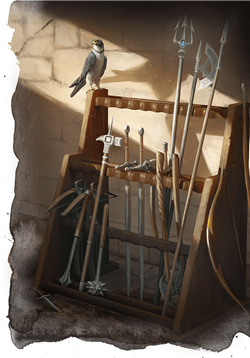 This guide focuses a lot on the “build” of your character, and how that build will help you in combat. Don’t forget that while a specific build can help you excel in combat, the most important choices in D&D are the ones you make while playing. Which enemy to attack, whether or not you try to intimidate or sweet-talk an unruly noble, or just what your character’s personality is.
This guide focuses a lot on the “build” of your character, and how that build will help you in combat. Don’t forget that while a specific build can help you excel in combat, the most important choices in D&D are the ones you make while playing. Which enemy to attack, whether or not you try to intimidate or sweet-talk an unruly noble, or just what your character’s personality is.
It’s totally okay to follow this guide to the letter and make a cookie-cutter fighter, but find one way to make your character your own. Choose a strong personality trait and have fun playing a greedy fighter, or a loving fighter, or so on. Then, even if your mechanical choices are fairly straightforward, you’ll always have something that makes your fighter your own.
Let’s go slay some dragons!
 James Haeck is the lead writer for D&D Beyond, the co-author of the Critical Role Tal'Dorei Campaign Setting, and a freelance writer for Wizards of the Coast, the D&D Adventurers League, and Kobold Press. He lives in Seattle, Washington and takes care of his two eldritch cats, Mei and Marzipan. You can usually find him wasting time on Twitter at @jamesjhaeck.
James Haeck is the lead writer for D&D Beyond, the co-author of the Critical Role Tal'Dorei Campaign Setting, and a freelance writer for Wizards of the Coast, the D&D Adventurers League, and Kobold Press. He lives in Seattle, Washington and takes care of his two eldritch cats, Mei and Marzipan. You can usually find him wasting time on Twitter at @jamesjhaeck.








-
View User Profile
-
Send Message
Posted Apr 3, 2018I would like to see an article like this for wizards, especially including optimized spell choices.
-
View User Profile
-
Send Message
Posted Apr 3, 2018-
View User Profile
-
Send Message
Posted Apr 4, 2018-
View User Profile
-
Send Message
Posted Apr 4, 2018Jeremy addressed the issue directly so it's your word against his; I know which one I'm going with. You're free to run the game however you like.
-
View User Profile
-
Send Message
Posted Apr 4, 2018-
View User Profile
-
Send Message
Posted Apr 4, 2018Doesn't the DM guide say that "The rules are meant to serve you, not the other way around" (I be paraphrasing)?, Though I do love a good if pointless debate.
-
View User Profile
-
Send Message
Posted Apr 7, 2018There appears to be a discrepancy/inconsistency about tanks and Eldritch Knight in the article:
In the "what kind of fighter are you" section, it says:
But Under "Fight like a fighter" 3rd level, it says:
So which is it?
-
View User Profile
-
Send Message
Posted May 14, 2018Nice, can't wait to play a fighter based on this.
-
View User Profile
-
Send Message
Posted Aug 10, 2018This awesome guide only covers the PHB fighter options, will there be an update covering the xanathar's guide subclasses?
-
View User Profile
-
Send Message
Posted Aug 26, 2018I enjoyed reading this, even though I've been playing D&D's various versions for 40 yrs. My regular group has been playing 5e for about 4 yrs, and I never changed from my boxed set character - so I'm playing a high dex Archery fighter. I've had fun with it, and so ghave the others around our table. Which leads me to this question: what weakness in the Archery FS is there that I've missed, that would preclude you from including it as a suggested option?
-
View User Profile
-
Send Message
Posted Aug 26, 2018What do you mean? It's right there in the guide:
-
View User Profile
-
Send Message
Posted Aug 26, 2018Wow Reading Is Fundamental! My apologies to all.
Thanks IC.
-
View User Profile
-
Send Message
Posted Oct 26, 2018I am trying to make a fighter subclass for a character I want to create. The site says that I need some required features with their associated levels. What are these required features?
Here is a link: https://www.dndbeyond.com/characters/subclasses/65367-samurai-calva
If that doesn't work, I can paste the subclass in here.
-
View User Profile
-
Send Message
Posted Dec 31, 2018This is either encouraging an illegal move or just simply badly worded.
If you cast a spell of 1st level or higher on your turn then attempt to cast a second spell during that same turn, using your action surge or bonus action, the only other spells you can cast are cantrips.
This is a magic rule that applies to all spellcasters and it was an oversight to not include a reminder within the Eldritch Knight and Quickened Metamagic descriptions.
-
View User Profile
-
Send Message
Posted Dec 31, 2018I regret to say that yours is an incorrect reading of the rules. The only rule prohibiting the casting of multiple leveled spells in a turn is specific to bonus actions. From the Player's Handbook:
While this does preclude casting two leveled spells using the sorcerer class's Quickened Spell Metamagic, it does not prevent an Eldritch Knight (or other spellcaster/fighter multi-class characters) from using an Action Surge to cast two leveled spells in a turn. This interpretation of the rules is supported by Jeremy Crawford.
-
View User Profile
-
Send Message
Posted Dec 31, 2018Interesting thing to note. If you cast a leveled spell as a bonus action, you can only cast cantrips with a casting time of 1 action even if you have access to Action Surge. "You can't cast another spell during the same turn, except for a cantrip with a casting time of 1 action." is pretty clear.
-
View User Profile
-
Send Message
Posted Dec 31, 2018Yup! I think that's a bit of a dodgy rules interaction, though, and I would consider houseruling that away.
-
View User Profile
-
Send Message
Posted Apr 17, 2019This is helpfully well-written as a guide for Fighters. However I have a couple of gripes regarding ways this article could be updated. The Archery fighting style is only mentioned once for Offensive Fighters as a side note. There are a number of ways to get mileage out of a ranged focused Fighter. Medium Armor + Longbow + Decent -> Good Dex + back up Whip means an archer can deal good damage before enemies close in, before switching to a reach weapon with the finesse property. Of course this is one specific example but there are many ways to play Fighters.
Especially with the release of the subclasses from Xanathar's Guide to Everything. The Samurai, Cavalier, and Arcane Archer all round out the Champion, Battle Master, and Eldritch Knight. And the variety of weapons isn't the only string to this bow. Fighter's excel at using equipment effectively. Using caltrops and ball bearings to slow enemies for instance. Alchemist Fire is an area of effect grenade which can be thrown using strength or dexterity. Action Surge can be used to Dodge, Dash, Disengage, Attack or used for specific items and skills. Personal recommendation: If your Fighter picks up spare the dying, a healing potion, medicine, a Healer's Kit, the [feat]Healer[/feat] feat, or a healing spell which requires an action can use Action Surge to become an emergency medic. (Also friendly tip; If you get one healing spell as a Fighter to use on allies, get Healing Word because it uses Bonus Action).
-
View User Profile
-
Send Message
Posted Jun 12, 2019What about gunslinger?
-
View User Profile
-
Send Message
Posted Jun 12, 2019The article only covers subclass choices from the Players Handbook. The gunslinger is a third-party subclass.